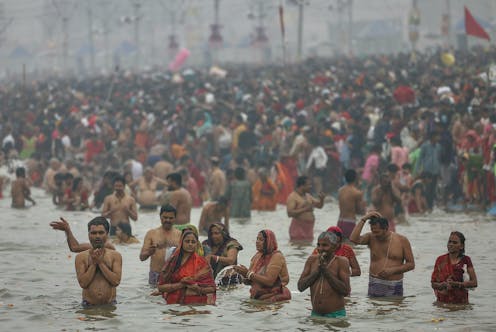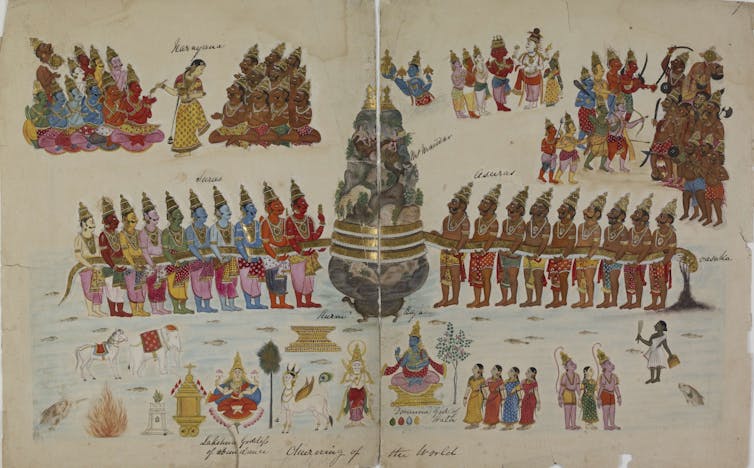Reverence for the sacred waters of the Ganga and belief in its power to wash away sins bring million
Ritual bathing at the confluence of large rivers has long held special significance in Hindu rituals. Sangam, where the Ganga and Yamuna are believed to meet the fabled Saraswati, is the most revered.

Millions of people have been visiting Prayagraj, a city in the northern Indian state of Uttar Pradesh, to take part in the Maha Kumbh festival – a six-week-long event that began on Jan. 13, 2025.
Called the world’s largest religious gathering, the event has already drawn 148 million people. Attendance is expected to exceed 400 million by the time it ends on Feb. 26, and surging crowds have already claimed dozens of lives at the sacred site.
Attendees range from Indian business tycoons and members of parliament to social media personages, film stars and celebrities, including the philanthropist billionaire Laurene Powell Jobs, widow of Apple founder Steve Jobs, who is a member of an ashram in Prayagraj.
As a historian of the Ganga and its ecology, I am captivated by the enduring power of unwavering devotion that continues to drive pilgrims to this sacred site, despite the dangers posed by surging crowds and the spread of contagion. At least 30 people have been trampled to death and 60 have been injured in the stampede that followed this year.
Ritual bathing at the confluence of large rivers has always had a special significance in Hindu rituals. Of such places, the Sangam, or confluence, at the city of Prayagraj is the most revered because this is where the rivers Ganga and Yamuna meet with the fabled Saraswati, also known as the goddess of learning and the arts – the unseen, mythical river that flows underneath.
Hindus believe that bathing at the pilgrimage of Prayag has the power to wash away every sin known to humankind.
Mythology behind the Kumbh
The Kumbh festival is named after the celestial pitcher or “kumbha” that held the much coveted “amrita,” the nectar of immortality. In Hindu mythology, during what is known as the Age of Truth, the powerful clans of the asuras (demons) and devas (gods) fiercely battled over the source of eternal life.
The cosmic ocean then was filled with milk, which they churned to draw out the nectar that would make them immortal. According to mythology, the asuras succeeded in the beginning, but their exertions disturbed Vasuki, the coiled, eternal snake at the Earth’s core, releasing a deadly poison that threatened to destroy the heavens. When the turn of the devas came, nectar was finally released from the depths of the netherworld. They drank the elixir and defeated the asuras.

During this epic battle, four drops of the nectar fell to the Earth in places that are held scared. Two are cities in present-day northern India, Haridwar and Prayag, and two in central India, Nashik and Ujjain – all located along meeting points of rivers.
An overwhelming multitude of people
The festival of the Kumbh also marks the 12-year orbital circuit of the planet Jupiter, or Brihaspati, the harbinger of good fortune and wealth.
The present gathering commemorates the Maha Kumbh, or “Great” Kumbh, which is an exceptionally rare and auspicious event that takes place once every 144 years, following the completion of 12 regular Kumbh cycles. This sacred gathering is celebrated exclusively at Prayag.
A gathering of this immense scale presents a monumental challenge for local and national authorities, testing their ability to coordinate the arrival and departure of hundreds of millions of people and housing them in thousands of tents in a city that is assembled just for the few weeks of the gathering.
It serves as a showcase of the nation’s organizational prowess while striving to preserve the sanctity of this ancient festival. Not only have sandbags been laid for miles along the banks where pilgrims are congregating, local authorities have deployed 2,760 CCTV cameras to keep track of the throngs, prevent stampedes and prevent families from being separated.
The 2025 event has been dubbed the first digital Maha Kumbh, where police and volunteers are using artificial intelligence-based software to locate missing people and deliver emergency alerts during unexpected crowd surges. They have also installed underwater drones to monitor bathers and prevent drowning. The state government allocated US$765 million (64 billion rupees) for infrastructure and support of police, medical staff and ambulances.
Despite extensive preparations, the early rush for a bathing spot in the Ganga spiraled out of control just before dawn on Jan. 26 and many people were trampled. Such tragedies are not new to the Kumbh gathering. During the 1954 Kumbh, a much more devastating stampede resulted in the deaths of nearly 800 people. A melee at the train station during the 2013 Kumbh killed 36 people.
The enduring appeal
Over the centuries, countless pilgrims have bathed and prayed in the Ganga, driven by the enduring belief that its waters possess the power to cleanse the spirit and cure diseases.
However, throngs of people wading into the Ganga often stoked the dread of infection and disease. In the latter half of the 19th century, during the heyday of British colonial rule, administrative officials considered mass ritual bathing at festivals such as Kumbh a great threat to public sanitation and hygiene and a potential source of cholera outbreaks. The colonial empire grew increasingly concerned after the number of pilgrims arriving in Prayag rose exponentially after the advent of the railways in the 1860s.
Despite such fears, barring isolated episodes of cholera – the last one being in 1906, attributed to pilgrims drinking water from polluted pools – there has been little evidence of a major epidemic at the Kumbh in recorded history.
Faith in the river’s purity has also been emboldened by research on high levels of oxygenation of the river water from algae and concentrations of the bacteriophage virus in the Ganga’s shallow pools, capable of eliminating harmful bacteria like E. coli.
The magnificent celebration of the Kumbh and the enduring reverence for the sacred waters of the Ganga reflect a live connection to both myth and history across the great subcontinent of India.
For the millions of pilgrims who bathe in the sacred waters, it is a continuation of the enduring belief in healing and spiritual redemption, both in this life and the next.
Sudipta Sen does not work for, consult, own shares in or receive funding from any company or organization that would benefit from this article, and has disclosed no relevant affiliations beyond their academic appointment.
Read These Next
The ‘one chatbot per child’ model for AI in classrooms conflicts with what research shows: Learning
AI tutors are often held up as an ideal, but prioritizing individualized teaching can detract from the…
Pardons are political, with modern presidents expanding their use
Trump and Biden have issued pardons at a faster clip than their predecessors. Many of their decisions…
Getting peace right: Why justice needs to be baked into ceasefire agreements – including Ukraine’s
Just war theory, a centuries-old field of ethics, deals with how and when to start conflicts. It can…






